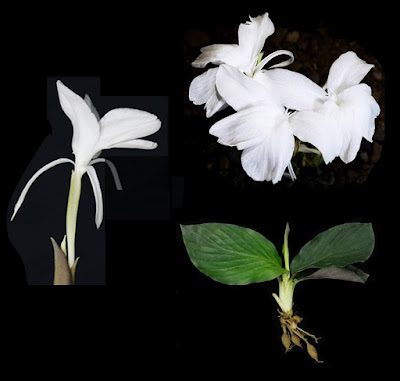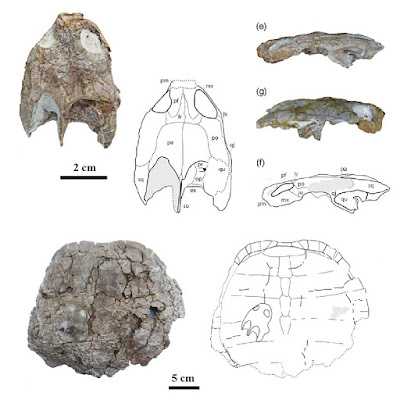[Most Recent Entries] [Calendar View]
Saturday, May 2nd, 2020
| Time | Event | ||||
| 4:29a | [Botany • 2020] Kaempferia albiflora (Zingiberaceae) เปราะแมงมุม • A New Species from Northern Thailand
Summary Kaempferia albiflora Jenjitt. & Ruchis., a new species from Northern Thailand, is described. It is similar to K. grandifolia Saensouk & Jenjitt. but differs in having erect, lanceolate to elliptic leaves, lobes of the labellum with a rounded apex, and a trilobed anther crest, whereas K. grandifolia has broadly ovate leaves appressed to the ground, lobes of the labellum with an acuminate apex, and a trilobed anther crest. Key Words: Endangered species, Northern Thailand, precocious flowering, Protanthium, Tak Province
Kaempferia albiflora Jenjitt. & Ruchis. sp. nov. RECOGNITION. This species is most similar to Kaempferia grandifolia Saensouk & Jenjitt. in its inflorescence appearing before the vegetative parts and its white flower with a yellowish patch at the base, but differs in having erect, lanceolate to elliptic leaves, lobes of the labellum with a rounded apex, and a trilobed anther crest, whereas K. grandifolia has broadly ovate leaves appressed to the ground, lobes of the labellum with an acuminate apex, and a bilobed anther crest (Table 1). Thaya Jenjittikul and Saroj Ruchisansakun. 2020. Kaempferia albiflora (Zingiberaceae), A New Species from Thailand. Kew Bulletin. 75; 13. DOI: 10.1007/s12225-020-9868-4 Nattapon Nopporncharoenkul, Woranuch Laongsri and Thaya Jenjittikul. 2020. Two New Species of Kaempferia subgenus Protanthium (Zingiberaceae) from northern Thailand. Nordic Journal of Botany. 38(2): e02633. DOI: 10.1111/njb.02633 | ||||
| 7:28a | [Paleontology • 2019] Kalasinemys prasarttongosothi • A New Xinjiangchelyid Turtle (Cryptodira: Xinjiangchelyidae) from the Late Jurassic of NE Thailand
Abstract A new xinjiangchelyid turtle, Kalasinemys prasarttongosothi n. gen. n. sp., is described on the basis of skull and shell material from the Upper Jurassic Phu Kradung Formation at Phu Noi locality, Kalasin Province, in NE Thailand. This second xinjiangchelyid turtle from Phu Noi is distinct from Phunoichelys thirakhupti by the smooth shell surface, the presence of a cervical notch, and vertebral 1 narrower than nuchal. The skull presents an arterial system characteristic of the Xinjiangchelyidae (basal Eucryptodira), and its outline is similar to that of Annemys spp. known from the Middle–Late Jurassic of China and Mongolia, but distinct from the latter mainly by the wider triturating surface, smaller foramen palatinum posterius and the shape of the prefrontal and frontal, as well as that of the basisphenoid and basioccipital. Based on the turtle assemblages, the correlation with mainland Asia further supports a Late Jurassic age for the lower part of the Phu Kradung Formation where Phu Noi site is located stratigraphically. Our study provides new insight on the evolution of the basal eucryptodiran turtles in Asia. Keywords: Testudines; Xinjiangchelyidae; Kalasinemys; systematic; Phu Kradung Formation; Late Jurassic; Thailand Testudines Linnaeus, 1758 Cryptodira Cope, 1868 Xinjiangchelyidae Nessov in Kaznyshkin et al., 1990 Kalasinemys prasarttongosothi gen. and sp. nov. Etymology: The genus name is from Kalasin Province, where the Phu Noi site is located. The species name is in honour of Dr Prasert Prasarttong-Osoth who supports palaeontological research and education in Thailand. Conclusion: A new genus and new species of Xinjiangchelyidae, Kalasinemys pasarttongosothi n. gen. n. sp., is erected on the basis of skull and shell material from the Phu Kradung Formation of the Khorat Plateau, NE Thailand. The skull presents an arterial system characteristic of the Xinjiangchelyidae (basal Eucryptodira), and its outline is similar to that of Annemys spp. However the skull of Kalasinemys is distinct from that of Annemys in having the more parallel lateral edges; the prefrontals extending posteriorly and forming most of the medial edge of the orbit; the reduced frontals with a long anterior process, short main body and small contribution to the orbital margin; the wider triturating surface; smaller foramen palatinum posterius; a scalene triangular-shaped basipterygoid process and a shorter basioccipital. Kalasinemys is the second taxon of Xinjiangchelyidae from the Phu Noi locality. It was a freshwater turtle as indicated by its morphology and the depositional environment. The turtle assemblage from Phu Noi has close affinities with those from the Middle–Late Jurassic of China and Central Asia. The correlation based on the turtle faunas supports a Late Jurassic age for the lower part of the Phu Kradung Formation to which the Phu Noi locality belongs. From a palaeobiogeographical point of view, it suggests a marked faunal interchange between SE Asia and more northern parts of Asia (China and Central Asia) at the time of deposition of the lower part of the Phu Kradung Formation. This discovery adds a new element to the still poorly known turtle fauna from the lower part of the Phu Kradung Formation in NE Thailand, and provides new insight on the evolution of the basal eucryptodiran turtles. Haiyan Tong, Wilailuck Naksri, Eric Buffetaut, Suravech Suteethorn, Varavudh Suteethorn, Phornphen Chantasit and Julien Claude. 2019. Kalasinemys, A New Xinjiangchelyid Turtle from the Late Jurassic of NE Thailand. Geological Magazine. 156(1); 1645-1656. DOI: 10.1017/S0016756818000791 |
| << Previous Day |
2020/05/02 [Calendar] |
Next Day >> |







